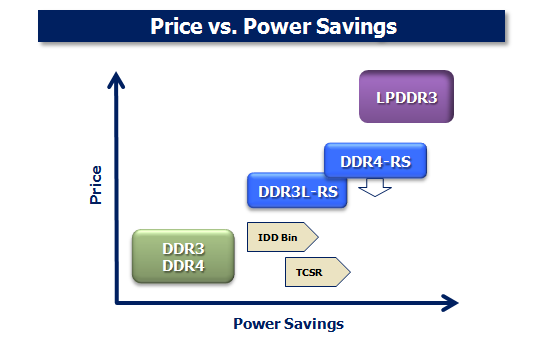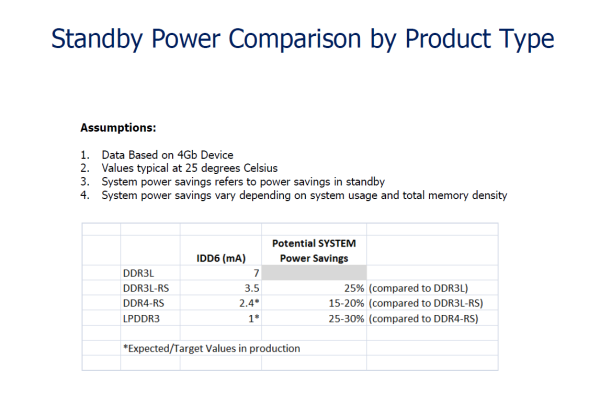Additional Details on Micron’s DDR3L-RS, DDR4-RS, and Other Memory
by Jarred Walton on September 22, 2012 7:02 PM ESTEarlier this week we posted a short write-up about Micron’s new DDR3L-RS memory. We didn’t have a lot of technical detail to go on at the time, but Micron offered us a chance to chat with them on the phone and we were able to get more information about DDR3L-RS as well as their other memory products. Memory is something many of us take for granted in our PCs and other computing devices, but there’s a lot more going on in the market than you might expect.
If you need the least expensive memory possible, DDR3 is currently the way to go. On the other hand, if you’re making a mobile device, finding memory that uses less power even if it costs more might be the best option. Naturally, there are plenty of other options that fall somewhere in between those extremes; Micron provided us with the following chart showing where the various memory types fall in terms of price vs. power requirements.

Starting at the top with LPDDR3 and other LPDDR products, their specialized nature is what gives them both their low power usage as well as their higher cost—consider how most tablets and smartphones only ship with 1GB LPDDR or less right now. Chiefly this comes because of the complexity of the devices; for example, the memory might be integrated into an SoC, or placed in a PoP package. The result is that while you can get the best power characteristics out of LPDDR, the volume is much lower as it’s generally not used in high volume markets like laptops and PCs with 8GB or more RAM. We haven’t seen any laptops that use LPDDR so far (at least, not that I’m aware of), but Intel reportedly has LPDDR3 support on their Ultrabook roadmaps, which would allow for improved battery life as well as smaller/thinner designs.
At the other end of the spectrum we have DDR3, a commodity memory where low price is generally the primary consideration. These devices are mass produced so economies of scale along with less difficult targets (e.g. 1.5V and DDR3-1600 speed) allow them to reach lower price points. Right now, for example, you can find a kit of 8GB DDR3-1600 CL9 SO-DIMMs for around $40 (and under $35 for DDR3-1333 and/or CL11).
One step up from DDR3 in terms of power efficiency is DDR3L, which targets 1.35V instead of 1.5V. Power scales linearly with voltage and current (P = V * I), and reducing the voltage typically reduces the current required for the chip as well, resulting in a substantial reduction in power draw. Getting chips that will run at a lower voltage is mainly a matter of binning, along with improvements in process technology, so the costs are very similar to regular DDR3. Sticking with the previous example, the same DDR3-1600 CL9 kits cost about 10% more if you get 1.35V DDR3L. Note that most DDR3L laptop kits will also run fine at 1.5V, but if you want to run at 1.35V you’ll generally need a laptop specifically designed to utilize the lower voltage—Apple’s MacBook Pros for instance use 1.35V CL11 memory.
Straddling the line between LPDDR3 and DDR3L, we have Micron’s new DDR3L-RS memory. The RS suffix stands for “Reduced Standby”, and through a process of binning along with a few extra features, Micron is able to cut standby power use for a system by around 25%. DDR3L-RS is also backwards compatible with the DDR3 standard, so there’s no change necessary at the controller level—all the extra work happens in the memory devices. Micron couldn’t discuss specific prices of their various memory types, but they did suggest that at the component level DDR3L-RS should cost around 20% more than DDR3L. In terms of power efficiency, Micron provided the following information showing their expected power savings:
One of Micron’s key features in reducing the amount of power used in standby mode is TCSR: Temperature Controlled Self Refresh. Most systems are specified to run the RAM at up to 85C when active, but in sleep mode the temperatures drop substantially and open the door for some additional power savings. In the case of Micron’s DDR3L-RS, once the temperature hits 45C or less, they can reduce how frequently RAM needs to be refreshed and thereby reduce the power draw. It's also important to remember that DDR3L-RS won't perform any better than DDR3L in active use; its benefits as the name implies are only when the memory/system is in standby.
We should note that while we’re talking about Micron’s specific memory, DDR3L-RS, it is expected that the other major memory manufacturers (e.g. Hynix, Elpida, Samsung, etc.) will have similar RAM technologies, though the specifics of how they save power may vary among the suppliers.
What about future memory technologies like DDR4? Micron also discussed some of their upcoming designs that leverage DDR4 with us, and like the switch from DDR2 to DDR3, the change from DDR3 to DDR4 will necessitate new memory controllers and will not be backwards compatible. One of the biggest changes with DDR4 is that the standard voltage drops from 1.5V (DDR3) down to 1.2V, enabling power savings over even DDR3L. Micron will also have DDR4-RS memory available, and we’ll likely see products start to use that (e.g. some tablets) as soon as late 2012/early 2013. While Intel hasn’t officially made any statements in regards to Haswell’s memory technology, the emphasis on reducing power use would make that an ideal time for Intel to switch from a DDR3 controller to DDR4—we should know more sometime in the coming months.
Wrapping up, obviously there’s no single “silver bullet” memory technology that works best for all markets. Paying a price premium for DDR3L or DDR3L-RS on a desktop just to save a couple watts of power doesn’t really make sense, while on laptops and in particular Ultrabooks the power savings could definitely be worthwhile. Like other DRAM manufacturers, Micron looks to offer a broad selection of DRAM devices for the whole array of options. The end result is that customers can choose based on cost, form factor, power, etc. and find the best balance of features and pricing for their product. Margins on memory products have become razor thin over the years, so anything that can help companies like Micron find a way to improve their bottom line is obviously something they will pursue; currently, the ultrathin computing initiative—tablets, Ultrabooks, sleekbooks, etc.—is really pushing for improvements in memory technology.
















24 Comments
View All Comments
Lonyo - Saturday, September 22, 2012 - link
All the low power stuff coming "next year" keeps making me think Windows 8 is almost a year too early (while also being a year too late).I'm getting tempted to buy something relatively inexpensive this year (the lowest non-Atom tablet), and then save up for something better next year when everything lower power comes out.
Penti - Saturday, September 22, 2012 - link
Well Windows RT gets released before Office 2013 RT so good luck there with early devices. It's not delivering this year. Even techies haven't quite realized how limiting RT edition is, as people don't even believe you if you say that Outlook won't be available on Windows RT, or that it will have worse exchange support then stock Android, iOS, Blackberry etc. So they don't see why you would stress 8 Pro devices and full featured apps. They don't quite realize that there already is deployed MDM (management) tools out there for iOS, Android etc and that they integrate fine in an Windows Server/Microsoft Server-products environment and handles sharepoint, exchange, office-formats, Lync etc in most cases better then the mobile Windows products do even after the introduction of Windows 8, Windows RT and Windows Phone 8. Microsoft have to lift up other strengths than stuff people makes up themselves. Hardware isn't key here either. You can do portable stuff just fine.Their competitor Apple will also run Haswell etc next year. It's not like they will match up better just because new stuff is out. Here typically lower power hardware just means smaller batteries. Nothing radical here yet either software or hardware sadly.
Impulses - Sunday, September 23, 2012 - link
I've been having the same feeling, between new memory tech, Haswell/A15, new WiDi updates and Thunderbolt, next year seems like a much better time for some of these early Win 8 hybrid/tablet devices. I guess it's like most things the first gen is always sort of a rough draft (even the first IPhone was a very rough approximation of what a smartphone is today, people forget there was no app store etc).Impulses - Sunday, September 23, 2012 - link
I'm really not sold on Win RT, specially with Clove Trail driving it... Just feels like a compromise on all fronts. Rather just upgrade my Android tablet with a cheap Nexus design than go that route. The higher end convertible/hybrid x86 designs intrigue me, but I don't think the first iteration of any of them is really gonna hit it out of the park.eanazag - Wednesday, September 26, 2012 - link
Windows RT runs on ARM based hardware, so no Clover Trail or ATOM anything. Think Tegra 3.twotwotwo - Sunday, September 23, 2012 - link
I mostly buy this theory for Pro (currently Ivy Bridge) tablets. In weight and battery life, they're more like touchscreen-only Ultrabooks than typical Android, etc. tabs. They're prolly going to be priced up there with some good ultraportables. But in a year, there'll be ones that are about as fast as today's, but significantly better at the whole mobile thing thanks to lower-power Intel ULV chips, etc. And you'd be plunking down a lot for a Surface Pro. So, all in all, there's more than usual reason to wait.(The Atom tabs may be 'mobile enough' already, but...$800, and you have Atom netbooks on one side and ARM tablets on the other. The Atom stuff looks really neat and unique in some ways, but that is some tough math to stomach.)
eezip - Saturday, September 22, 2012 - link
The article says "Power scales linearly with voltage", but that's untrue. P = V^2 / R, so power scales exponentially with voltage. Therefore, a small decrease in voltage has a much larger decrease in power consumption.eezip - Saturday, September 22, 2012 - link
I could be more clear. Power does scale linearly when considering P = I * V, but it's unclear to me if the load impedance (and thus current consumption) of the memory changes with a change in voltage. I suspect current is relatively flat, and impacted more by the temperature increase from running at a higher voltage (greater leakage at higher temp) than anything else.http://www.powersystemsdesign.com/performance-vs-p... for example, states a 20% reduction in power when going from 1.35V to 1.5V. 1.35V is 90% of 1.5V, then showing that a 10% reduction in voltage leads to a 20% reduction in power.
eezip - Saturday, September 22, 2012 - link
And http://www.micron.com/~/media/Documents/Products/T... on page 13, corroborates my original post. By saying that reducing voltage reduces current by the same amount, that means the load resistance of the memory is virtually fixed. Therefore, P = V^2 / R is the correct equation and power does not scale linearly with voltage.I'm finding out there's no way to edit a post. Boo.
Zink - Saturday, September 22, 2012 - link
Wow, good job finding documentation on that right from Micron. It's well understood by enthusiasts that CPU power is related exponentially to voltage but I wasn't 100% sure about how memory behaves.1.5V to 1.35V then is a 19% reduction in power draw.